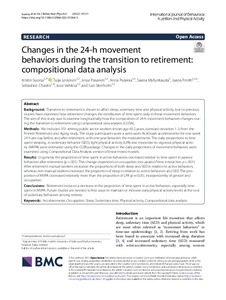Changes in the 24-h movement behaviors during the transition to retirement: compositional data analysis
Pasanen Jesse; Vahtera Jussi; Stenholm Sari; Myllyntausta Saana; Pulakka Anna; Leskinen Tuija; Suorsa Kristin; Pentti Jaana; Chastin Sebastien
https://urn.fi/URN:NBN:fi-fe2022112967711
Tiivistelmä
Background
Transition to retirement is shown to affect sleep, sedentary time and physical activity, but no previous studies have examined how retirement changes the distribution of time spent daily in these movement behaviors. The aim of this study was to examine longitudinally how the composition of 24-h movement behaviors changes during the transition to retirement using compositional data analysis (CoDA).
Methods
We included 551 retiring public sector workers (mean age 63.2 years, standard deviation 1.1) from the Finnish Retirement and Aging study. The study participants wore a wrist-worn ActiGraph accelerometer for one week 24 h per day before and after retirement, with one year between the measurements. The daily proportions to time spent sleeping, in sedentary behavior (SED), light physical activity (LPA) and moderate-to-vigorous physical activity (MVPA) were estimated using the GGIR package. Changes in the daily proportions of movement behaviors were examined using Compositional Data Analysis version of linear mixed models.
Results
In general, the proportion of time spent in active behaviors decreased relative to time spent in passive behaviors after retirement (p < .001). This change depended on occupation (occupation*time interaction p < .001). After retirement manual workers increased the proportions of both sleep and SED in relation to active behaviors, whereas non-manual workers increased the proportion of sleep in relation to active behaviors and SED. The proportion of MVPA decreased relatively more than the proportion of LPA (p = 0.01), independently of gender and occupation.
Conclusions
Retirement induced a decrease in the proportion of time spent in active behaviors, especially time spent in MVPA. Future studies are needed to find ways to maintain or increase daily physical activity levels at the cost of sedentary behaviors among retirees.
Kokoelmat
- Rinnakkaistallenteet [19218]
